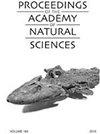新泽西州的伍德伯里组(坎帕尼亚)发现了北美已知最大的白垩纪硬骨鱼耳石组合
IF 0.5
4区 环境科学与生态学
Q4 BIODIVERSITY CONSERVATION
Proceedings of the Academy of Natural Sciences of Philadelphia
Pub Date : 2016-11-28
DOI:10.1635/053.165.0101
引用次数: 8
摘要
摘要在美国新泽西州南部的石桥地区,在Woodbury组上部(早-中坎帕尼亚期)发现了硬骨石耳石,其产状具有重要意义。首先,新泽西白垩纪的耳石实际上是未知的,因为大多数地层已经被广泛地浸出,这破坏了文石耳石。其次,从伍德伯里组获得的耳石数量是前所未有的,有3555个样本被发现,这是迄今为止在北美发现的最大的白垩纪耳石组合。最后,耳石保存得相当完好,便于分类。这些因素加上早中期坎帕尼亚时代(约83.6±0.2 Ma至77.9±0.2 Ma),形成了以耳石为代表的最古老、最丰富的鱼类组合之一,不仅在北美,而且在世界上也是如此。耳石可能表明存在至少29个硬骨动物分类群,代表14个科,包括巨骨类、硬骨类(包括翼石类)、gonostomatids、硬骨类、副硬骨类、粗骨类、berycoids、pempherids和几种percomorphs。沉积学和古生物学资料,包括耳石,表明受主要河流和三角洲影响的浅海古环境(小于100米)。伍德伯里耳石组合的演化意义非常重要。表演兽的耳石已经出现,并提供了尚未由骨骼遗骸所表明的证据,证明了几个分类群的已知时间范围延伸到了坎帕尼亚。伍德伯里的耳石证实了最近几项关于硬骨鱼的主要分子定年研究(在化石年龄限制下对线粒体和核基因进行DNA测序)。该研究也代表了对新泽西州白垩纪耳石的首次系统研究,对更好地了解新泽西州晚白垩纪硬鱼有重要贡献。本文章由计算机程序翻译,如有差异,请以英文原文为准。
Woodbury Formation (Campanian) in New Jersey yields largest known Cretaceous otolith assemblage of teleostean fishes in North America
ABSTRACT. Teleostean otoliths have been recovered from the upper portion of the Woodbury Formation (early-middle Campanian) at the Stone Bridge locality in southern New Jersey, and their occurrence is highly significant for several reasons. First, otoliths are virtually unknown in the New Jersey Cretaceous since most of the formations have been extensively leached, which destroys the aragonitic otoliths. Second, the number of otoliths obtained from the Woodbury Formation is unprecedented with 3,555 specimens recovered, which represents the largest Cretaceous otolith assemblage ever described from North America. Finally, the otoliths are fairly well preserved allowing taxonomic assignment. These factors coupled with the early-middle Campanian age (approximately 83.6 ± 0.2 Ma to 77.9 ± 0.2 Ma) result in one of the oldest, most prolific fish assemblages represented by otoliths, not just in North America, but in the world. Otoliths may indicate the presence of at least 29 teleostean taxa representing 14 families including megalopids, albulids (including pterothrissids), gonostomatids, aulopids, paraulopids, trachichthyids, berycoids, pempherids, and several percomorphs. Sedimentological and paleontological data, including the otoliths, suggest a shallow, marine paleoenvironment (less than 100 m) influenced by major rivers and deltas. The evolutionary implications of the Woodbury otolith assemblage are quite important. Otoliths of percomorphs are present and provide evidence, not yet indicated by skeletal remains, that extend into the Campanian the known time ranges of several taxa. The Woodbury perciform otoliths corroborate several recent major molecular dating studies of teleosts (DNA sequencing of mitochondrial and nuclear genes with fossil age constraints). This study also represents the first systematic study of Cretaceous otoliths from New Jersey and contributes substantially to a better understanding of the Late Cretaceous teleosts in New Jersey.
求助全文
通过发布文献求助,成功后即可免费获取论文全文。
去求助
来源期刊

Proceedings of the Academy of Natural Sciences of Philadelphia
生物多样性保护-生物多样性保护
自引率
0.00%
发文量
4
期刊介绍:
The Proceedings (ISSN 0097-3157) has been published continuously since 1841. Many volumes are still available in their original printings. Early volumes are unbound, constituting two or three issues per year. Quantities of some volumes may be limited. Early volumes may have slightly soiled cover sheets, but the text blocks are perfect.
 求助内容:
求助内容: 应助结果提醒方式:
应助结果提醒方式:


